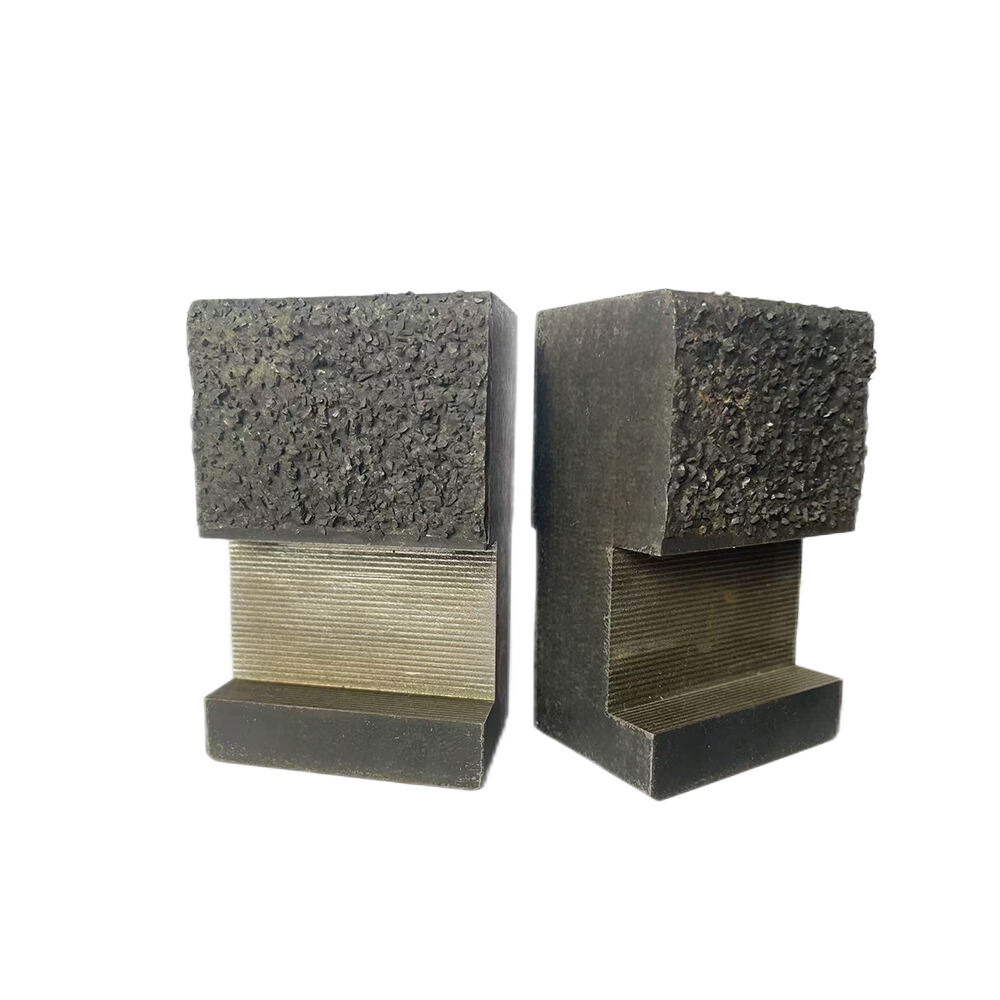Förstå de centrala mekanikerna i industriell malmningsteknologi
I hjärtat av varje industriell malmningsoperation finns en kritisk komponent som bestämmer hela processens effektivitet och kvalitet - hammarmalsblad. Dessa avgörande element är mer än bara bitar av metall; de är precisionskonstruerade verktyg som omvandlar råvaror till perfekt dimensionerade partiklar genom en kombination av slag-, skjuv- och attritions krafter.
Prestandan hos hammarslagsmalsklingor påverkar direkt produktionshastigheter, energiförbrukning och slutproduktskvalitet. Oavsett om man bearbetar spannmål för djurfoder, minskar biomassa för produktion av biodrivmedel eller förbereder material för läkemedelsapplikationer, spelar vetenskapen bakom dessa klingor en avgörande roll för att uppnå önskade resultat.
Designelement i högpresterande malsystem
Klingmaterialets sammansättning och hållbarhet
Materialets sammansättning i hammarslagsmalsklingor påverkar deras livslängd och prestanda avsevärt. Moderna klingor innehåller vanligtvis legeringar av stål med högt kolinnehåll, ofta förbättrade med tillsatsser som krom, mangan och andra element för att öka slitstyrkan. Dessa noggrant utvalda material säkerställer optimal hårdhet samtidigt som de behåller den seghet som krävs för att tåla upprepade slagkrafter.
Avancerade metallurgiska processer, såsom värmebehandling och ythärdning, förbättrar ytterligare bladens hållbarhet. Denna sofistikerade konstruktion förlänger livslängden och upprätthåller en konsekvent partikelstorleksfördelning under hela malningsprocessen.
Geometriska överväganden och slagmönster
Hammarverkets blads geometri är en avgörande faktor för att bestämma malningseffektiviteten. Bladvinklar, tjocklek och kantprofiler är noggrant beräknade för att optimera slagkraftsfördelning och materialflödesmönster. Moderna konstruktioner har ofta specialiserade skärkanter som främjar enhetlig partikelminskning samtidigt som energiförbrukningen minimeras.
Ingenjörer måste balansera olika faktorer när de konstruerar bladgeometri, inklusive spetsens hastighet, matningshastighet och önskad partikelstorlek. Interaktionen mellan dessa element skapar specifika slagmönster som direkt påverkar malningsprocessens effektivitet.

Driftsfaktorer som påverkar bladprestanda
Hastighet och slagkraftsdynamik
Förhållandet mellan rotorns hastighet och slagkraft är grundläggande för hammarmalens bladseffektivitet. Högre hastigheter leder i allmänhet till större slagkrafter, men de ökar också slitagehastigheten och energiförbrukningen. Att hitta den optimala balansen kräver en förståelse för materialets specifika egenskaper och önskade utdataegenskaper.
Modern hammarmalsutrustning innefattar ofta variabla hastighetskontroller, vilket tillåter operatörer att justera bladhastighet beroende på materialkarakteristik och produktionskrav. Denna flexibilitet optimerar både energieffektivitet och produktkvalitet över olika applikationer.
Flödeshastighetsstyrning och materialflöde
Rätt flödeshastighetskontroll är avgörande för att maximera hammarmalens bladsprestanda. För hög påfyllning kan leda till reducerad effektivitet och ökat slitage, medan för låg påfyllning resulterar i onödig energiförbrukning. Interaktionen mellan flödeshastighet och bladsdesign bestämmer effektiviteten i partikelstorleksminskning.
Avancerade matningsstyrningssystem övervakar och justerar materialflödet i realtid, vilket säkerställer optimal bladlastning och konsekvent produktkvalitet. Den här sofistikerade metoden för matningshantering förlänger bladlivslängden samtidigt som höga genomströmningstakter upprätthålls.
Underhållsstrategier för optimal prestanda
Slitageanalys och rotationsprotokoll
Regelbundna inspektioner av hammarmulens blad avslöjar slitemönster som indikerar systemets prestanda och potentiella problem. Att förstå dessa mönster hjälper underhållsteam att utveckla effektiva rotationsscheman som maximerar bladlivslängden och upprätthåller malmeffektiviteten.
Att införa systematiska rotationsprotokoll säkerställer jämn slitagedistribution över alla blad, vilket förhindrar onödiga utbyten och optimerar driftkostnaderna. Den här proaktiva underhållsmetoden förlänger utrustningens livslängd samtidigt som konsekvent produktkvalitet upprätthålls.
Utbytesplanering och prestandaövervakning
För att bestämma den optimala tidpunkten för att byta knivblad i en hammarmalta krävs noggrann övervakning av flera parametrar. Prestandaindikatorer som energiförbrukning, kapacitetsflöde och partikelstorleksfördelning hjälper till att identifiera när knivbladens effektivitet börjar sjunka.
Modern övervakningssystem använder sensorer och dataanalys för att följa knivbladens prestanda i realtid, vilket möjliggör prediktivt underhåll som optimerar byte av scheman och minimerar driftstopp.
Framtida innovationer inom bladteknik
Avancerade Material och Beläggningar
Framtiden för hammarmaltsblad ligger i utvecklingen av avancerade material och ytbehandlingar. Nya legeringssammansättningar och beläggningsteknologier lovar att förlänga bladens livslängd samtidigt som malteffektiviteten förbättras. Dessa innovationer fokuserar på att minska slitagehastigheterna samtidigt som optimala slagkarakteristik behålls.
Forskning kring keramiska kompositmaterial och nano-teknikytor visar på potentiella genombrott vad gäller bladens slitstyrka och prestanda. Dessa utvecklingar kan revolutionera effektiviteten i industriella malloperationer.
Smart övervakning och adaptiva system
Integrering av smarta tekniker förändrar hanteringen av hammarmallsblad. Artificiell intelligens och maskininlärningsalgoritmer analyserar driftsdata för att optimera bladets prestanda och förutsäga underhållsbehov. Dessa system anpassar sig till föränderliga förhållanden och säkerställer konsekvent produktkvalitet samtidigt som utrustningens livslängd maximeras.
Utvecklingen av självreglerande system som automatiskt optimerar bladparametrar baserat på materialens egenskaper och produktionskrav representerar nästa stora landvinning inom mällteknik.
Vanliga frågor
Hur ofta bör hammarslagsmalsblad bytas ut?
Byteintervall beror på olika faktorer såsom materialhårdhet, driftsförhållanden och produktionsvolym. Vanligtvis bör blad kontrolleras veckovis och bytas när slitage överskrider tillverkarens specifikationer eller när prestandamätningar visar på minskad effektivitet. De flesta anläggningar finner att optimala byteintervall ligger mellan 3-6 månader med lämpliga rotationsprotokoll.
Vilken påverkan har bladmaterial på prestanda?
Bladmaterial påverkar i hög grad slitstyrka, slipningsprestanda och driftskostnader. Högkollegers stållegeringar med specifika hårdhetsgrader erbjuder den bästa balansen mellan slitstyrka och slagstyrka. Premiummaterial kan kosta mer från början men ger ofta bättre värde genom förlängd livslängd och konsekvent prestanda.
Hur kan bladlivslängden förlängas?
För att maximera bladets livslängd bör du implementera regelbundna rotationsplaner, upprätthålla korrekta matningshastigheter och säkerställa rätt rotorhastighetsinställningar. Regelbunden rengöring och inspektion, i kombination med korrekt materialselektion för att ta bort trampmetall, förlänger bladets livslängd avsevärt. Dessutom hjälper användning av automatiska övervakningssystem till att förhindra överdriven slitage genom tidig identifiering av prestandaproblem.
